
A punch bowl or punchbowl is a bowl, often large and wide, in which the drink punch is served. [2]

A punch bowl or punchbowl is a bowl, often large and wide, in which the drink punch is served. [2]
The word punch is a loanword from Hindi. The original drink was named paantsch, which is Hindi for "five", and the drink was made from five different ingredients: spirit, sugar, lemon, water or tea and spices. The drink was brought back from India to England by the sailors and employees of the British East India Company in the early seventeenth century, and from there it was introduced into other European countries. [2]

Punch quickly became a popular drink. It was served in punch bowls, usually ceramic or silver, which were often elaborately decorated. Punch bowls sometimes had lids or were supported on a stand; other accessories such as a serving ladle and cups in which to serve the drink sometimes accompanied the punch bowl. Punch bowls were often painted with inscriptions or were used for testimonial purposes: the first successful whaling voyage from Liverpool was commemorated by a punch bowl presented by the owners of the ship to its captain. [3]
The ubiquity of the punch bowl as a household item is illustrated in this 1832 quote:
The punch-bowl was an indispensable vessel in every house above the humblest class. And there were many kindly recollections connected with it, it being very frequently given as a present. No young married couple ever thought of buying a punch-bowl; it was always presented to them by a near-relative. [3]
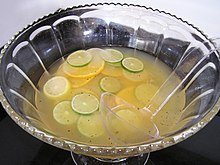
Occasionally, less likely vessels were used as punch bowls, such as a marble fountain to serve 6,000:
On the 15th October 1694 Admiral Edward Russell, then commanding the Mediterranean fleet, gave a grand entertainment at Alicante. The tables were laid under the shade of orange-trees, in four garden-walks meeting in a common centre, at a marble fountain, which last, for the occasion, was converted into a Titanic punch-bowl. Four hogsheads of brandy, one pipe of Malaga wine, twenty gallons of lime-juice, twenty-five hundred lemons, thirteen hundredweight of fine white sugar, five pounds' weight of grated nutmegs, three hundred toasted biscuits, and eight hogsheads of water, formed the ingredients of this monster-brewage. An elegant canopy placed over the potent liquor, prevented waste by evaporation, or dilution by rain; while, in a boat, built expressly for the purpose, a ship-boy rowed round the fountain, to assist in filling cups for the six thousand persons who partook of it. [3]

At times, punch bowls were used as baptismal fonts in dissenting families. [3]
The American poet Oliver Wendell Holmes wrote the poem On Lending a Punch-bowl about an old silver punch bowl. [8]
In English usage, large, bowl-shaped landscape features (often the head of combes or valleys) were occasionally given the name punch bowl, such as the Devil's Punch Bowl in Surrey or Punchbowl Crater ("The Punchbowl") on the island of Oahu in Hawaii.

A caudle was a hot drink that recurred in various guises throughout British cuisine from the Middle Ages into Victorian times. It was thick and sweet, and seen as particularly suitable and sustaining for invalids and new mothers. At some periods of history, caudle recipes were based on milk and eggs, like eggnog. Later variants were more similar to a gruel, a sort of drinkable oatmeal porridge. Like the original forms of posset, a caudle was usually alcoholic.

Squash is a non-alcoholic beverage with concentrated syrup used in beverage making. It is usually fruit-flavoured, made from fruit juice, water, and sugar or a sugar substitute. Modern squashes may also contain food colouring and additional flavouring. Some traditional squashes contain herbal extracts, most notably elderflower and ginger.
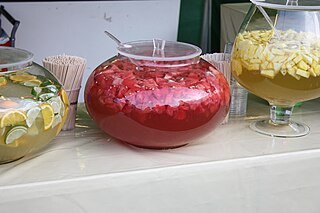
The term punch refers to a wide assortment of drinks, both non-alcoholic and alcoholic, generally containing fruits or fruit juice. The drink was introduced from the Indian subcontinent to England by employees of the East India Company in the late 17th century. Punch is usually served at parties in large, wide bowls, known as punch bowls.

Punsch is a specific type of alcoholic liqueur and punch popular in Sweden and Finland. It is most frequently described as Swedish Punsch, and while historical variations have also been called Militär Punsch, Arrack Pun(s)ch, and Caloric Pun(s)ch, punsch should not be confused with the term "punch" as used generically. It is made by the mixing of spirits with arrak tea, sugar, and water, and was first brought to Sweden from Java in 1733. The spirit arrack is the base ingredient in most punsches, also imported into Europe by the Dutch from their colony in Batavia, Dutch East Indies. Punsch usually has 25% alcohol by volume (ABV) and 30% sugar.
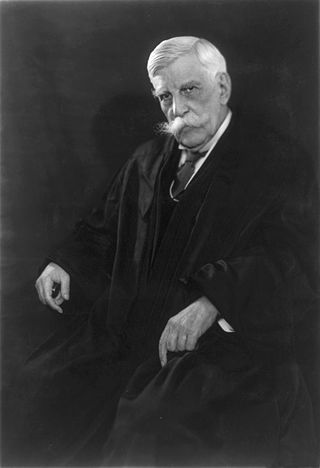
Oliver Wendell Holmes Jr. was an American jurist and legal scholar who served as an associate justice of the U.S. Supreme Court from 1902 to 1932. Holmes is one of the most widely cited Supreme Court justices and among the most influential American judges in history, noted for his long service, pithy opinions—particularly those on civil liberties and American constitutional democracy—and deference to the decisions of elected legislatures. Holmes retired from the court at the age of 90, an unbeaten record for oldest justice on the Supreme Court. He previously served as a Brevet Colonel in the American Civil War, in which he was wounded three times, as an associate justice and chief justice of the Massachusetts Supreme Judicial Court, and as Weld Professor of Law at his alma mater, Harvard Law School. His positions, distinctive personality, and writing style made him a popular figure, especially with American progressives.

Oliver Wendell Holmes Sr. was an American physician, poet, and polymath based in Boston. Grouped among the fireside poets, he was acclaimed by his peers as one of the best writers of the day. His most famous prose works are the "Breakfast-Table" series, which began with The Autocrat of the Breakfast-Table (1858). He was also an important medical reformer. In addition to his work as an author and poet, Holmes also served as a physician, professor, lecturer, inventor, and, although he never practiced it, he received formal training in law.

Eggnog, historically also known as a milk punch or an egg milk punch when alcoholic beverages are added, is a rich, chilled, sweetened, dairy-based beverage. It is traditionally made with milk, cream, sugar, egg yolks, and whipped egg whites. A distilled spirit such as brandy, rum, whisky or bourbon is often a key ingredient.

A bowl is a typically round dish or container generally used for preparing, serving, or consuming food. The interior of a bowl is characteristically shaped like a spherical cap, with the edges and the bottom forming a seamless curve. This makes bowls especially suited for holding liquids and loose food, as the contents of the bowl are naturally concentrated in its center by the force of gravity. The exterior of a bowl is most often round, but can be of any shape, including rectangular.

Syllabub is a sweet dish made by curdling sweet cream or milk with an acid such as wine or cider. It was a popular British confection from the 16th to the 19th centuries.
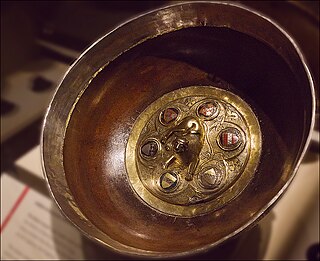
A mazer is a special type of wooden drinking vessel, a wide cup or shallow bowl without handles, with a broad flat foot and a knob or boss in the centre of the inside, known technically as the print or boss. They vary from simple pieces all in wood to those ornamented with metalwork, often in silver or silver-gilt. They use dense impervious woods such as maple, beech and walnut wood. They are a north European medieval tradition, mostly made from the 11th to the 16th centuries.
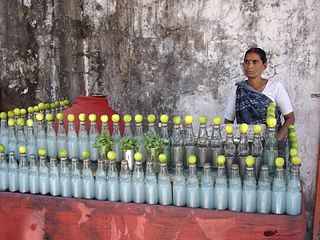
Banta Soda, or Banta, also Goli Soda or Goti Soda and Fotash Jawl, is a popular carbonated lemon or orange-flavoured soft drink sold in India since the late 19th century in a distinctly shaped iconic Codd-neck bottle. The pressure created by the carbonated liquid seals the bottle by forcing a glass marble up into the neck of the bottle where it snugly locks into a rubber gasket. Opening the bottle by pressing on the marble thus releasing the pressurised gas is seen to be a fun experience. The drink is easily available at street-sellers, known as bantawallahs, at prices ranging from ₹5 (6.3¢ US) – ₹30 (38¢ US). The drink is sold in glass tumblers and plastic cups, and used to be served in kulhars.

Punchbowl is a suburb south west of Sydney, 17 kilometres (11 mi) west of the Sydney central business district, in the local government area of the City of Canterbury-Bankstown, in the state of New South Wales, Australia. At the 2016 census, Punchbowl had a population of 20,236.
A Scorpion Bowl is a communally shared alcoholic tiki drink served in a large ceramic bowl traditionally decorated with wahine or hula-girl island scenes and meant to be drunk through long straws. Bowl shapes and decorations can vary considerably. Starting off as a single-serve drink known as the Scorpion cocktail, its immense popularity as a bowl drink in tiki culture is attributed to Trader Vic.

A flaming drink is a cocktail or other mixed drink that contains flammable, high-proof alcohol, which is ignited before consumption. The alcohol may be an integral part of the drink, or it may be floated as a thin layer across the top of the drink. The flames are mostly for dramatic flair. However, in combination with certain ingredients, the flavor of the drink is altered. Some flavors are enhanced, and the process may impart a toasted flavor to some drinks.
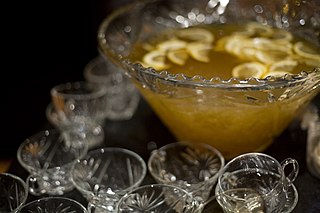
Fish house punch is a strong, rum-based punch containing rum, cognac, and peach brandy. The drink is typically served over an ice block in a punch bowl and garnished with lemon slices.

A finger bowl is a bowl of water that dinner guests use for rinsing their fingers. In a formal meal, the finger bowl is brought to the table at the time of the dessert course of the meal, and guests set it aside for use after the last course, just before leaving the table. In less formal service, the finger bowl may be presented after any course that involves finger food and may even be presented after more than one such course in a single meal.
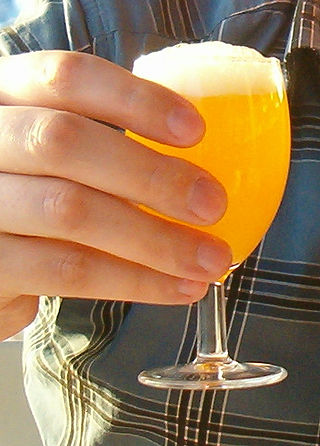
Poncha is a traditional alcoholic drink from the island of Madeira, made with aguardente de cana, honey, sugar, and either orange juice or lemon juice. Some varieties include other fruit juices.

The Sydney punchbowls, made in China during the Jiaqing Emperor's reign (1796–1820) over the mid-Qing dynasty, are the only two known examples of Chinese export porcelain hand painted with Sydney scenes and dating from the Macquarie era. The bowls were procured in Canton about three decades after the First Fleet's arrival at Port Jackson where the British settlement at Sydney Cove was established in 1788. They also represent the trading between Australia and China via India at the time. Even though decorated punchbowls were prestigious items used for drinking punch at social gatherings during the 18th and 19th centuries, it is not known who originally commissioned these bowls or what special occasion they were made for.
punch bowl.
punch bowl oliver.